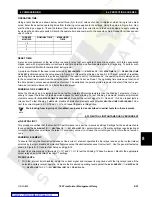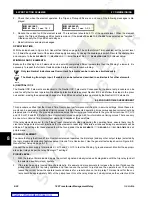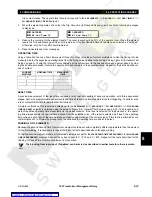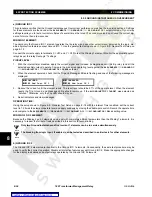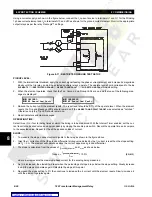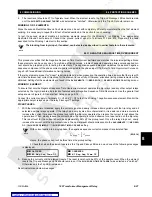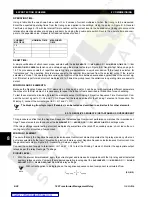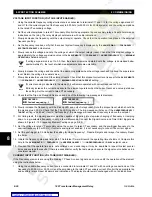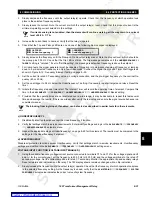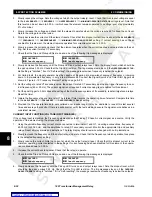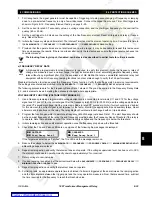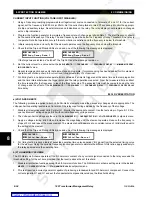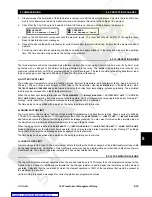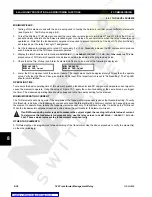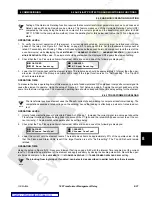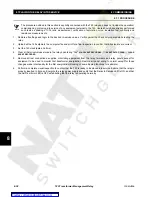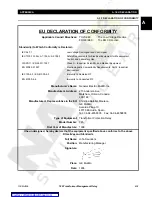
8-34
745 Transformer Management Relay
GE Multilin
8.5 PROTECTION SCHEMES
8 COMMISSIONING
8
CURRENT INPUT FUNCTION (VOLTAGE INPUT DISABLED):
1.
Using a frequency-ramping programmable voltage/current source connected to terminals H1 and G1 for the current
signal, set the frequency to 60.00 Hz (or 50Hz). Set the current amplitude to rated CT secondary. Monitor the appropri-
ate trip and auxiliary relays. Reset all alarms and indications on the relay. The relay display should remain unchanged
with no trip indications.
2.
Program the function generator to simulate a frequency rate-of-change just above Rate 1. The start frequency should
be the nominal frequency of the relay. The end frequency must be below the Frequency Decay Threshold if the relay is
to operate. Note that operation occurs if the rate criterion is satisfied and the frequency is below the threshold.
3.
Initiate ramping action and verify that the element operates once the frequency drops below the threshold.
4.
Check that the Trip and Pickup LEDs are on and one of the following trip messages is displayed:
If the target was selected as "Latched", the Trip LED and the message remain on.
5.
Set the current level to a value below the
S4 ELEMENTS
ÖØ
FREQUENCY
ÖØ
FREQUENCY DECAY
ÖØ
MINIMUM OPERAT-
ING CURRENT
value.
6.
Repeat ramping action and verify that element does not operate.
If current sensing has been disabled for this element,
operation will continue down to a current level of approximately 2% of nominal.
7.
For timing tests, an approximate operate time is obtained if a timer is triggered at the same time as the ramping action
and the time interval between the trigger point and the relay operation measured. From that measured time, subtract
the time required for the frequency to reach the threshold value. The expected time must be computed using the rate
of change and the effect of the
S4 ELEMENTS
ÖØ
FREQUENCY
ÖØ
FREQUENCY DECAY
ÖØ
FREQUENCY DECAY DELAY
time delay.
8.5.14 OVEREXCITATION
a) VOLTS-PER-HERTZ
The following procedure applies to both Volts-Per-Hertz elements; make the necessary changes where appropriate. The
volts-per-hertz operating levels are set in terms of the relay-input voltage divided by the frequency of that voltage.
1.
Disable all elements except Volts-Per-Hertz 1. Monitor the appropriate contact. Use the test setup in Figure 8–12: Fre-
quency Element Testing on page 8–29 with variable-frequency voltage source.
2.
The Volts-per-hertz settings are found in the
S4 ELEMENTS
ÖØ
OVEREXCITATION
Ö
VOLTS-PER-HERTZ 1
setpoints menu.
3.
Apply a voltage starting at 60 Hz and increase the magnitude until the element operates. Reduce the frequency in
steps of 5 Hz and repeat the measurement. The element should operate at a consistent value of Volts/Hertz equal to
the setting of the element.
4.
Check that the Trip and Pickup LEDs are on and one of the following trip messages is displayed:
5.
For timing tests, prepare a table of expected operating time versus applied V/Hz signal from the selected timing curve
for the element. Using the variable frequency function generator to simulate the different V/Hz ratios, apply suddenly to
the relay and measure the operating time.
b) 5TH HARMONIC SCHEME
The 5th Harmonic Scheme operates if the 5th harmonic content of any current signal connected to the relay exceeds the
threshold setting, for the set time, provided that the level is above the set threshold.
1.
Disable all protection functions except the 5th Harmonic function. The 5th Harmonic scheme settings are in the
S4 ELE-
MENTS
ÖØ
OVEREXCITATION
ÖØ
5TH HARMONIC LEVEL
setpoints menu.
2.
This test requires a current generator capable of producing a fundamental and 5th harmonic component. Connect the
current signal to H1 and G1 and set the fundamental component level above the threshold setting.
LATCHED
Freq Decay Rate 1
OPERATED
Freq Decay Rate 1
LATCHED
Volts-Per-Hertz 1
OPERATED
Volts-Per-Hertz 1


